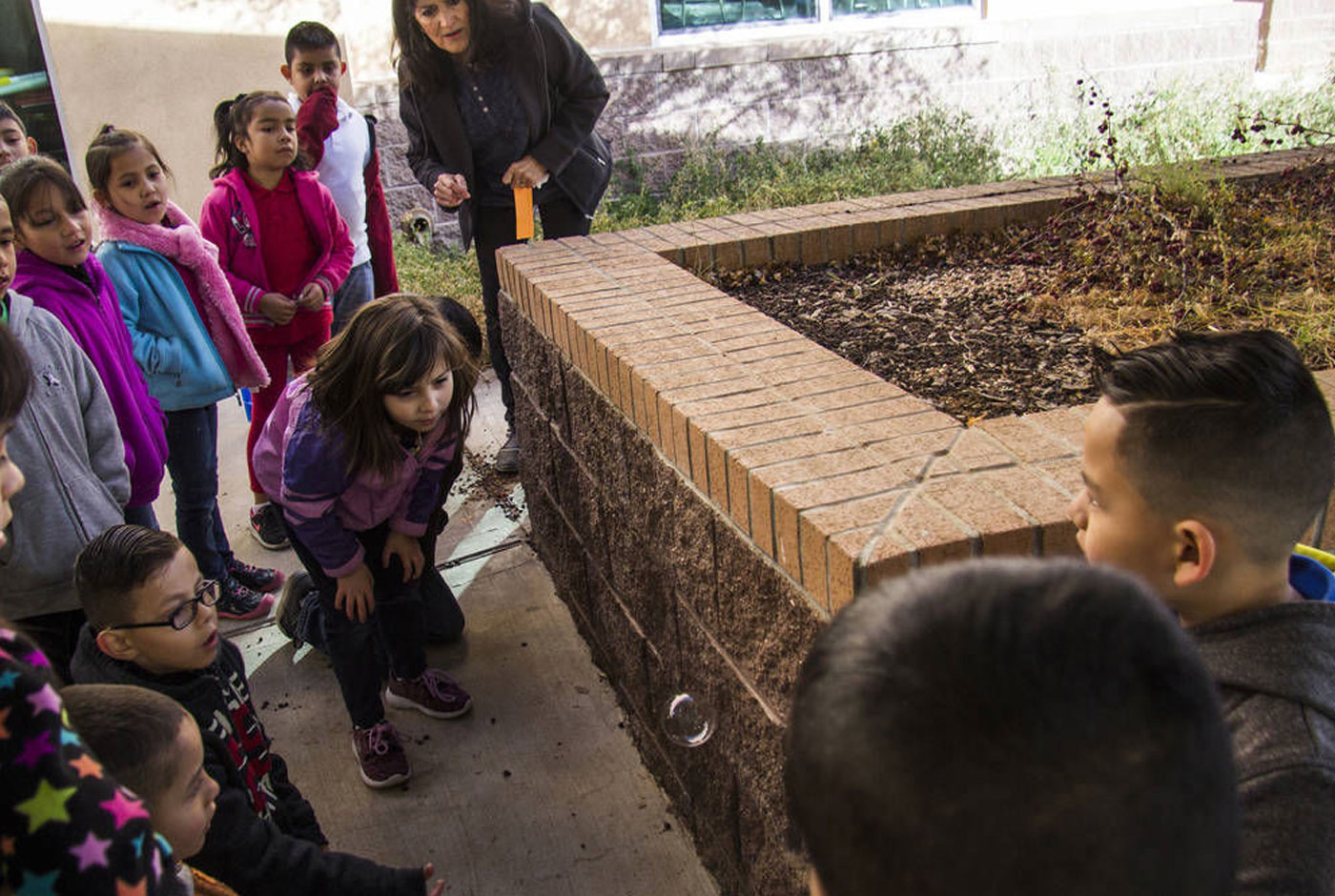Photo above: First-graders in Rita Rios-Baca’s class watch Nov.19 as a bubble drifts around a brick wall, in a demonstration of wind and air patterns. Sami Edge, The New Mexican.
By Robert Nott | The New Mexican | Nov 26, 2017
Ramirez Thomas Elementary School teacher Rita Rios-Baca’s first-graders let her know in one collective shout what they thought of her plan to use bubbles to study wind patterns as part of a Los Alamos National Foundation project that brings science into public school classrooms.
“Hooray!” they screamed in unison as they readied their science kits and notebooks under the watchful eye of Rios-Baca and school Principal Loretta Booker.
Within minutes, they were outside the south-side school, blowing bubbles and observing the way they moved with the wind — sometimes north, sometimes south and sometimes right into their own faces.
They were playing science detectives, in a sense: talking in groups about what they had witnessed and making notes plotting out the trajectory of the bubbles and how that correlated to the way the grass, bushes and tree limbs moved in response to the wind.
It was part of an effort to provide a hands-on approach to learning that makes them excited about a topic that a lot of students may see as boring or too technical or challenging.
“For me it brings science to life,” said Booker, who used the foundation science kits as a kindergarten teacher at Salazar Elementary School a few years ago.
Rita Rios-Baca on Nov. 19 discusses wind with her first-grade students after using bubbles to demonstrate basic principles of wind and weather. Sami Edge, The New Mexican.
The foundation is celebrating its 20th year supporting public schools with science curriculum and kits at the K-6 level through an $80 million endowment. Each grade level at each school gets two kits — one revolving around physical science and one involving earth science. The foundation gives teachers four days of professional development every summer on the program, paying the teachers for their time. It also offers ongoing classes during the school year on Friday afternoons.
Earlier this school year the students learned through the program about air pressure, how to build a thermometer and how to document daily weather patterns.
“If they conduct science like this they will think like scientists, write like scientists and develop critical thinking skills like scientists,” said Gwen Warniment, who oversees the foundation’s K-12 science inquiry program, which encompasses 44 schools spanning eight districts.
But that inquisitive approach may not always pay off in standardized test scores, as Warniment acknowledges. Recent exam results released by the Public Education Department showed that just 40 percent of the state’s students were proficient or better in science. In Santa Fe’s public schools, that proficiency rate was 31.7 percent.
The gap between hands-on learning and standardized-test improvement, Warniment said, is that many tests allow no room for using creative thinking skills or reconstructing experiments involving bubbles, rocks, weights and measures or chemicals.
“Is that a good measure to teach science education?” she asked of the test.
Likewise, the state’s push to ensure its students are reading and writing and handling math problems at a proficient level has encouraged educators to focus more on those topics, possibly at the expense of science, she said.
But if science was, to some, the forgotten topic, it came back to the forefront in the past few months after the Public Education Department published its proposed new science standards for the state, which generated controversy because it eliminated such concepts as the age of the earth, evolution and humans’ impact on climate change.
The foundation, among others, successfully urged the Public Education Department to instead adopt the Next Generation Science Standards, a more uniform and comprehensive approach that many states around the nation have adopted.
Some data does indicate the foundation’s science curriculum and kits are making a difference. In 2014, for example, the foundation released a report conducted by an independent research company in San Antonio, Texas, showing that the program helped students in fourth through sixth grades who took part in the program score an average of four to seven points higher than their peers in science, reading, math and writing.
The program ties what the students learn to reading and writing, Warniment said. For example, Rios-Baca pushed them to use the experiment as a jumping-off point to speak, read and write in full sentences — employing such new vocabulary words as “direction,” “observe” and “move.”
For the kids, there’s no getting around the fact that they were tuned in and turned on.
Nina Cerda (left) and a classmate work Nov.19 on drawing diagrams of how wind moves bubbles as part of a science experiment in Rita Rios-Baca’s first grade class at Ramirez Thomas Elementary School. Sami Edge, The New Mexican.
Alejandra Chacon, who sported a pair of mouse ears on her head during class, said she enjoyed it all “because I like science.”
For Niza Cerda, it was all about “bubbles and having fun.”
Axel Martinez said: “I like it because I want to learn so much.”
Asked how many wanted to grow up to be scientists, about a third of the group raised their hands.
That’s a heartwarming response for some, but Booker said it’s not just about setting kids on a career course. A program like this one, she maintains, can keep them in school.
“Sometimes I feel that students, when they have a hard time coming to school or say they don’t like school, may still find that one subject that they enjoy doing that can spark their interest to come to school,” she said. “Science can be that one subject area, and that makes it a powerful tool.”
Contact Robert Nott at 505-986-3021 or rnott@sfnewmexican.com.
Read the article in the New Mexican

